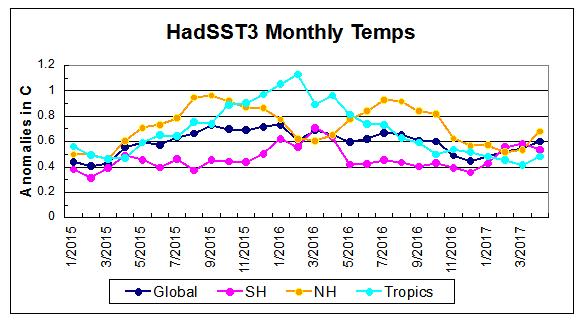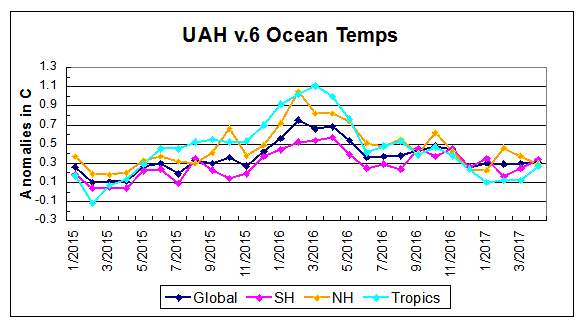
Ocean temperature measurements come from a global array of 3,500 Argo floats and other ocean sensors. Credits: Argo Program, Germany/Ifremer
April Sea Surface Temperatures are now available, and we can see a pause in the downward trajectory over the previous 13 months.
HadSST is generally regarded as the best of the global SST data sets, and so the temperature story here comes from that source, the latest version being HadSST3.
The chart below shows the last two years of SST monthly anomalies as reported in HadSST3 including April 2017.
In April 2017, the SH appears to be entering its cooler phase, while both the tropics and NH ticked upward from March, causing the Global anomaly to rise for the fourth month in a row. The downward momentum has stopped, except now the SH (mostly ocean) has started down from a lower peak than a year ago. It was the SH that was pulling up the Global average the previous three months. The Tropics and NH may or may not start a new warming cycle, depending upon the appearance of El Nino.
Note that higher temps in 2015 and 2016 were first of all due to a sharp rise in Tropical SST, beginning in March 2015, peaking in January 2016, and steadily declining back to its beginning level. Secondly, the Northern Hemisphere added two bumps on the shoulders of Tropical warming, with peaks in August of each year. Also, note that the global release of heat was not dramatic, due to the Southern Hemisphere offsetting the Northern one.
Satellite measures of the air over the oceans give a similar result. The graph below provides UAH vs.6 TLT (lower troposphere temps) over the oceans confirming the impression from SSTs.
Once again it is the Tropical and NH oceans that drove the warming that peaked a year ago. SH moderated the Global averages, though the air temps over the oceans are more synchronized than is the case with SSTs. Note how in April all anomalies converged on 0.3C.
We have seen lots of claims about the temperature records for 2016 and 2015 proving dangerous man made warming. At least one senator stated that in a confirmation hearing. Yet HadSST3 data for the last two years show how obvious is the ocean’s governing of global average temperatures.
The best context for understanding these two years comes from the world’s sea surface temperatures (SST), for several reasons:
- The ocean covers 71% of the globe and drives average temperatures;
- SSTs have a constant water content, (unlike air temperatures), so give a better reading of heat content variations;
- A major El Nino was the dominant climate feature these years.

Solar energy accumulates massively in the ocean and is variably released during circulation events.

